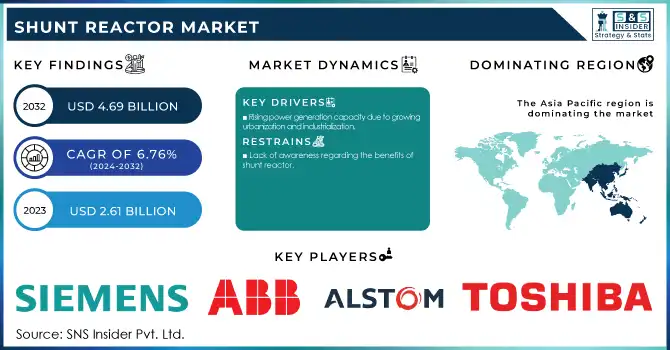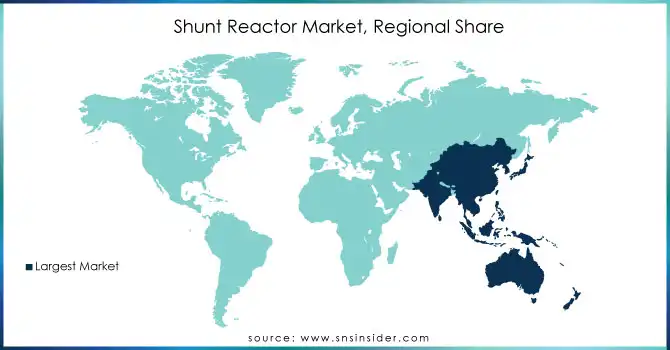Shunt Reactor Market Report Scope & Overview:

Get More Information on Shunt Reactor Market - Request Sample Report
The Shunt Reactor Market was valued at USD 2.61 Billion in 2023 and is projected to reach USD 4.69 Billion by 2032, growing at a compound annual growth rate (CAGR) of 6.76% from 2024 to 2032.
The Shunt reactor acts as an absorber as it absorbs the reactive power in cables and increases the energy and power efficiency of the system. To control the voltage during load variations it is used in high-voltage energy transmission systems. For the three-winding transformer, the shunt reactor is connected to the tertiary winding of the transformer otherwise it is directly connected to the power line.
The Shunt reactor is similar to the power transformer in construction but the main difference between them is power transformer transfers the energy or power from one voltage to another while the shunt reactor is used to consume reactive power. Moreover, the Shunt reactor has only one winding per phase and the power transformer has three windings. For large load currents shunt reactor has poor efficiency.
The shunt reactor basically reduces the voltage increase at low loads and keeps it within the desired voltage limit and helps to stabilize the system. It also helps to improve power quality and reduces the transmission cost. The most significant characteristics of the shunt reactor include power factor, thermal rating, impedance & audio sound level.
Market Dynamics
Drivers
-
Increasing demand for renewable energy to reduce the carbon footprint
-
Rising power generation capacity due to growing urbanization and industrialization
-
Modernization of aging technology
-
Increasing adoption of high-voltage transmission line
-
Rapidly growing demand for energy across the world
The accelerating energy demand across the globe put pressure on the government and energy-supplying sector to supply power continuously as per the need of the consumer. Therefore, they prefer to invest more in the upgradation of traditional power supply to fulfill the demand for energy. This factor positively impacted the shunt reactor market globally.
Restrain
-
Emerging alternative advanced technology
-
Lack of awareness regarding the benefits of shunt reactor
Opportunities
-
Increasing adoption of smart grid technology
-
Rising investment in the distribution and transmission infrastructure
Challenges
-
High cost associated with the shunt reactor
-
Environmental concern regarding the shunt reactor
Due to the complex design and use of expensive material i.e. aluminum and copper shunt reactors are more expensive than the other reactors. Due to this many end users prefer other reactors than shunt reactors. The shunt reactor contains a harmful chemical named Polychlorinated biphenyl leak into the environment and can affect human health.
Impact of COVID-19
The COVID-19 pandemic impacted almost all the industries severely. The power and energy industry also suffered during this outbreak which ultimately decreases the demand for shunt reactors across the globe. The decreased utilization of electricity, stringent restrictions due to lockdown, and the halting of commercial and industrial operations are the factor that affects the shunt reactor market drastically. According to the International Energy Agency, during COVID-19 the demand for electricity is reduced by nearly 20% in various countries. This energy demand reduction was a challenge for many markets to overcome the losses caused during the pandemic.
Impact of Russia-Ukraine War:
The ongoing conflict between Russia and Ukraine has had a significant impact on the shunt reactor market. The market for shunt reactors has been affected by the war in several ways.
Firstly, the war has disrupted the supply chain of shunt reactors. Many manufacturers source their raw materials from Ukraine, which has been affected by the conflict. Secondly, the political instability and economic sanctions imposed on Russia have led to a decline in the country's demand for shunt reactors. This has resulted in a decrease in production and sales of shunt reactors, affecting the revenue of manufacturers and suppliers. Lastly, the war has led to an increase in the cost of production and transportation of shunt reactors. The conflict has resulted in the closure of borders and increased security measures, leading to higher transportation costs. Additionally, the economic sanctions imposed on Russia have led to an increase in the cost of raw materials, further increasing the cost of production.
Impact of Recession:
The global economic recession has had a significant impact on various industries, including the shunt reactor market. Shunt reactors are essential components in power transmission and distribution systems, and their demand is closely linked to the growth of the power sector. However, the recession has caused a decline in the demand for electricity, resulting in a decrease in the demand for shunt reactors.
The shunt reactor market has experienced a slowdown in growth due to the recession. The market has witnessed a decline in sales, and many manufacturers have been forced to reduce their production capacity. The decrease in demand has also led to a decrease in prices, which has affected the profitability of the industry.
Key Market Segmentation
On the basis of Product, the Shunt Reactor Market is further segmented into Fixed and Variable.
On the basis of Type, the Shunt Reactor Market is further segmented into Oil Immersed and Air Core
On the basis of Phase, the Shunt Reactor Market is further classified into Single Phase and Three Phase
On the basis of End-user, the Shunt Reactor Market is further bifurcated into Electric Utilities and Industrial Verticals
By Product
-
Fixed
-
Variable
By Type
-
Oil Immersed
-
Air Core
By Phase
-
Single Phase
-
Three Phase
By End-user
-
Electric Utilities
-
Industrial Verticals
Regional Analysis
Asia Pacific dominated the shunt reactor market globally and is anticipated to grow significantly with the highest CAGR during the forecast period. The main reason behind this dominance is the Asia-Pacific is the largest producer and consumer of electricity. To satisfy the demand for energy from consumer countries in this region taking the initiative to increase the adoption of renewable energy sources is another factor that drives the shunt reactor market significantly. Increasing investment in the grid, reactors, and transformers, and adoption of high voltage transformation networks are the other factors that drive the market for shunt reactors.
Europe is also expected to show lucrative growth as Europe is also a major market for the reactors. This growth is attributed to the presence of advanced power grid infrastructure in the developed countries of Europe and increasing demand for electricity across the residential, commercial, and industrial sectors.

Need any customization research on Shunt Reactor Market - Enquiry Now
REGIONAL COVERAGE:
-
North America
-
USA
-
Canada
-
Mexico
-
-
Europe
-
Germany
-
UK
-
France
-
Italy
-
Spain
-
The Netherlands
-
Rest of Europe
-
-
Asia-Pacific
-
Japan
-
south Korea
-
China
-
India
-
Australia
-
Rest of Asia-Pacific
-
-
The Middle East & Africa
-
Israel
-
UAE
-
South Africa
-
Rest of the Middle East & Africa
-
-
Latin America
-
Brazil
-
Argentina
-
Rest of Latin America
-
Key Players
The major players are Siemens AG, ABB Limited, Alstom SA, Toshiba, Crompton Greaves, Zaporozhtransformator, Fuji Electric, Mitsubishi Electric Corporation, Hyundai Heavy Industries, Tebian Electric Apparatus Stock Company Ltd., Hitachi and other players
| Report Attributes | Details |
| Market Size in 2023 | US$ 2.52 Bn |
| Market Size by 2031 | US$ 4.42 Bn |
| CAGR | CAGR of 7.3% From 2024 to 2031 |
| Base Year | 2023 |
| Forecast Period | 2024-2031 |
| Historical Data | 2020-2022 |
| Report Scope & Coverage | Market Size, Segments Analysis, Competitive Landscape, Regional Analysis, DROC & SWOT Analysis, Forecast Outlook |
| Key Segments | • By Product (Fixed and Variable) • By Type (Oil Immersed and Air Core) • By Phase (Single Phase and Three Phase) • By End-user (Electric Utilities and Industrial Verticals) |
| Regional Analysis/Coverage | North America (USA, Canada, Mexico), Europe (Germany, UK, France, Italy, Spain, Netherlands, Rest of Europe), Asia-Pacific (Japan, South Korea, China, India, Australia, Rest of Asia-Pacific), The Middle East & Africa (Israel, UAE, South Africa, Rest of Middle East & Africa), Latin America (Brazil, Argentina, Rest of Latin America) |
| Company Profiles | Siemens AG, ABB Limited, Alstom SA, Toshiba, Crompton Greaves, Zaporozhtransformator, Fuji Electric, Mitsubishi Electric Corporation, Hyundai Heavy Industries, Tebian Electric Apparatus Stock Company Ltd., Hitachi |
| Key Drivers | • Increasing demand for renewable energy to reduce the carbon footprint • Rising power generation capacity due to growing urbanization and industrialization |
| Market Opportunities | • Increasing adoption of smart grid technology • Rising investment in the distribution and transmission infrastructure |

